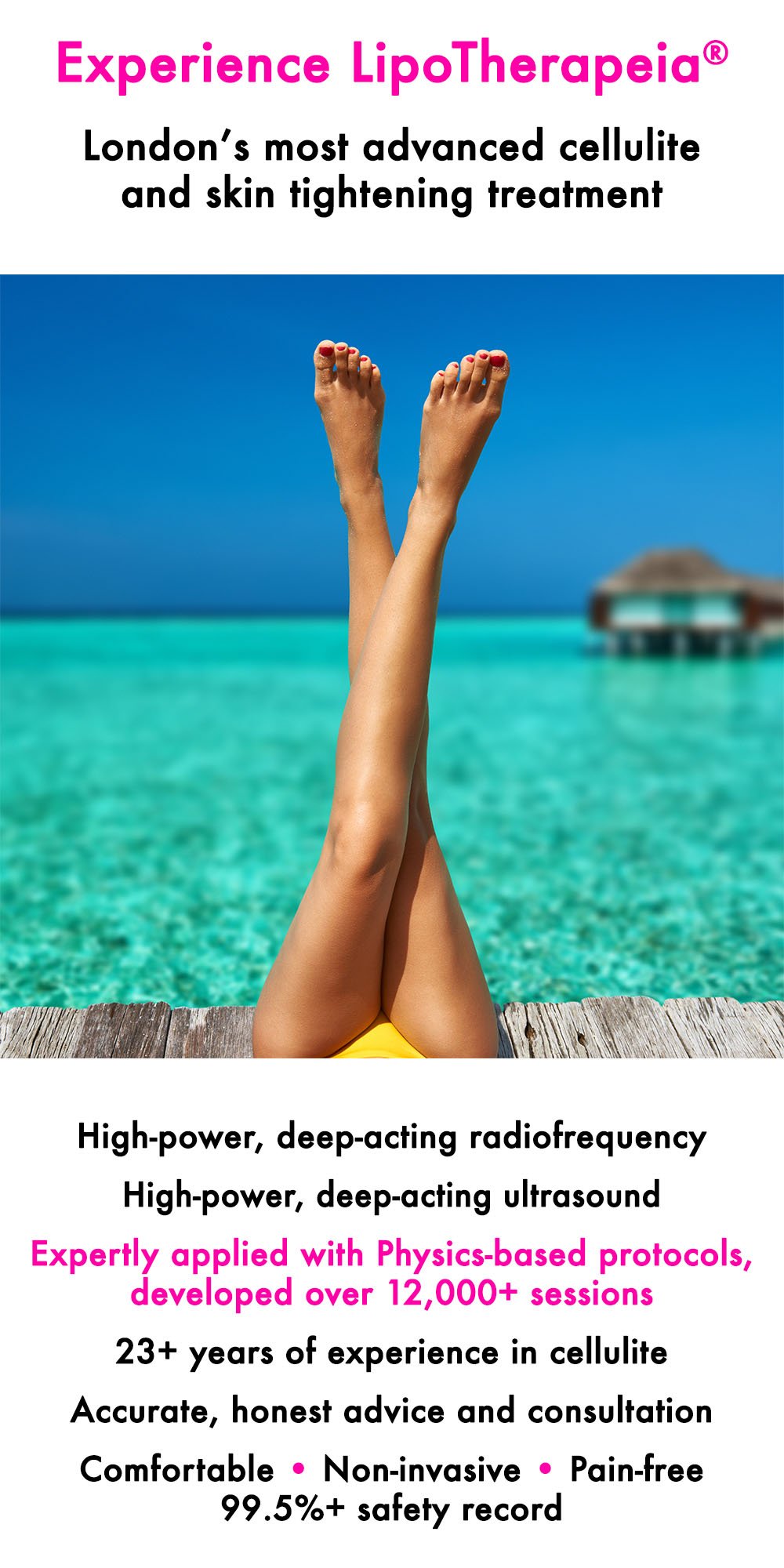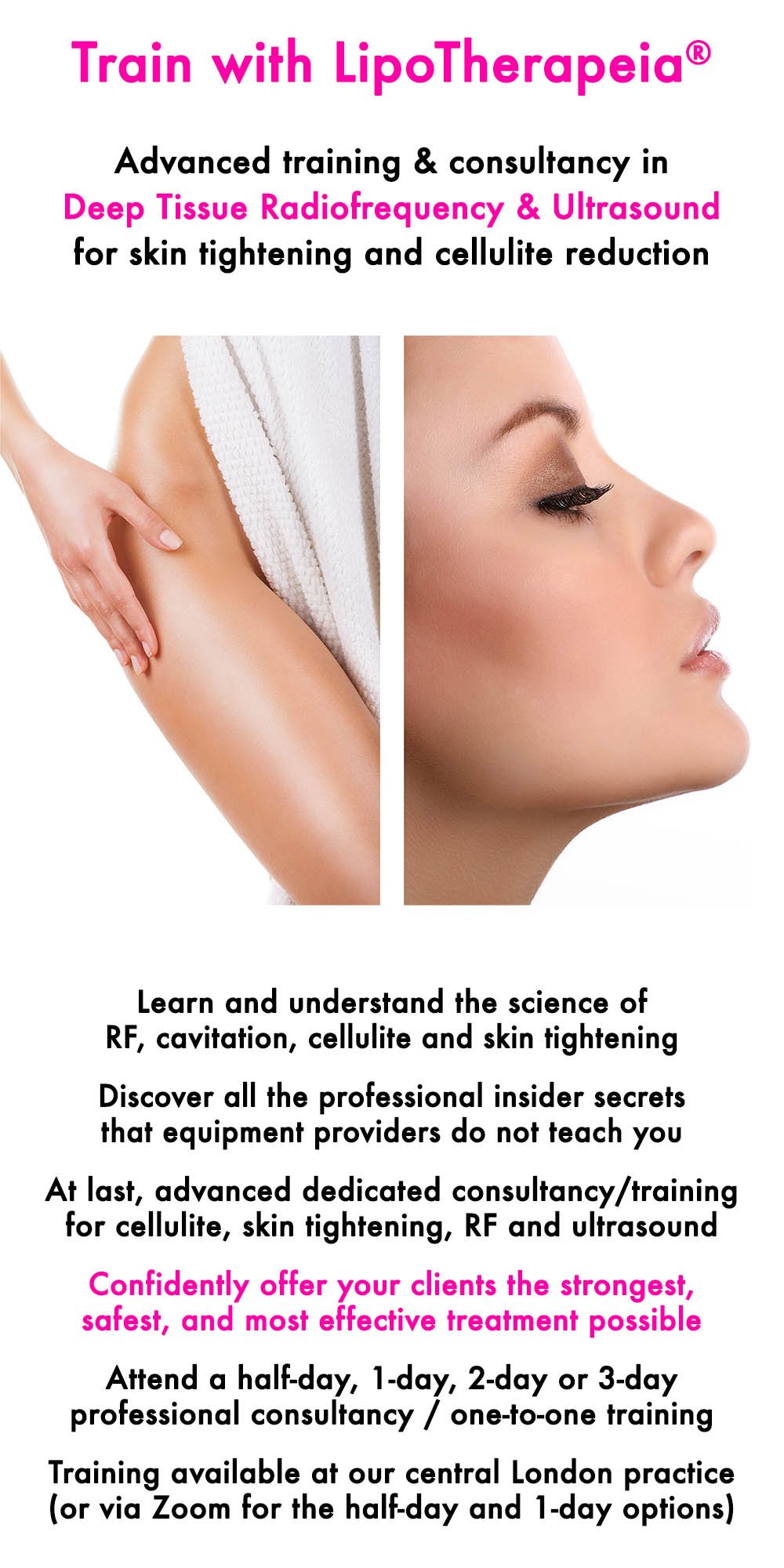“TL;DR: The ketogenic diet can help a lot of people lose weight fast. As long as you ensure you consume a lot of omega-3 fatty acids (fish, walnuts, flax/chia seeds) and vegetables (in the latter stages of the diet) than it can work well.
However, unhealthy keto options that include lots of fatty meat, butter and fried food - and not much else - although still technically being keto, are not sustainable health-wise, and therefore not a good idea for either cellulite prevention/reduction, weight loss of overall health and wellness.”
Is the keto diet good for cellulite?
What is the ketogenic diet?
Does keto work for fat loss? Is keto easy
Cyclical ketogenic diet (CKD) options, 5:2 or 6:1
Is the ketogenic diet healthy?
Sure, it is simple to follow and usually effective for general fat loss, but does keto help with cellulite?
Have a skin tightening/cellulite treatment in London with the experts
Advanced, infrared / red light therapy treatments in London at LipoTherapeia
Discover our professional training in cellulite, skin tightening, radiofrequency and ultrasound
What is the ketogenic diet?
The ketogenic diet is one of the most popular diets, used for weight loss and to help manage specific health conditions (diabetes, epilepsy, multiple sclerosis and more).
The ketogenic diet involves consuming a very small - to negligible - amount of carbohydrates, in order to lower glucose and insulin levels and lead to the production of ketones by the body.
(In the initial stages the limit is 10-20g of carbs per day at most and at later stages up to 50g, max.)
In the absence of glucose from carbohydrates the body produces ketones, which provide energy to the brain and other organs in glucose’s place.
Due to the lowering of glucose/insulin fluctuations, hunger and consequent food intake decreases (usually - not always), leading to weight loss.
Does keto work for fat loss? Is keto easy?
“Going keto” is quite easy for some people and extremely hard for some others. I have personally tried the keto diet a couple of decades ago for a few months and after an initial adjustment period I acclimatised to the new diet quite well.
Unfortunately my mood was affected by the lack of carbs. Carbohydrate intake leads to increase tryptophan absorption into the brain which is then converted to serotonin, the “feel-good” neurotransmitter. With less carbs less serotonin is produced in the brain.
Still I persisted and went on to lose about 8-9kg in just a few weeks.
However, boredom with the same food choices again and again led me to gradually give up the diet.
On the other hand, my partner tried the keto diet and it did not really work for her.
Everyone is different and for whoever the keto diet works, it makes sense - for a while.
In the long term, most people give up, as there are way to many temptations around us and not ever touching carbs again is not an option for most people, unless they follow the ketogenic diet for health reasons. For example, a client at the clinic managed to almost eliminate her multiple sclerosis symptoms by following the ketogenic diet.
Cyclical ketogenic diet (CKD) options, 5:2 or 6:1
One can follow a milder version of this diet, which is more sustainable: the cyclical ketogenic diet.
This usually involves starting with 7-day a week “full keto” for a few weeks and then switching to keto 5 days a week and then relaxed eating (but not going crazy on carbs) for 2 days on the weekends (5:2 keto). Some people do a more strict 6:1 diet, whereby they only have carbs once a week.
The benefit of a cyclical ketogenic diet is the “weekend reward” / “break the boredom” aspect of the diet, which makes it more sustainable long-term. The drawback is the sometimes slower results.
Another benefit is that during the weekend one can stock on on vitamins, minerals, carotenoids and polyphenols, found in vegetables and fruits, which are restricted during the week.
Is the ketogenic diet healthy?
Some doctors are afraid that the keto diet might raise cholesterol and triglyceride levels in the blood, but this is not very well thought out: the majority of both cholesterol and triglycerides is produced by the liver, due to the intake of sugars and excess carbs, and only secondarily is derived by fat intake in the food.
Furthermore, fat intake does not need to be of the saturation fat type. Nuts, seeds, avocados, olive oil and oily fish, for example, are rich in unsaturated fats and will actually reduce cholesterol and triglycerides in the blood.
And sure enough, if bacon, fried chicken or fatty cuts of meat are consumed after being cooked at high temperatures, then indeed, keto is very unhealthy.
Finally, some people claim that going keto will deprive you of plant-derived vitamins and other nutrients. This may be true for the stricter first four weeks of the keto diet, when you try to restrict carbs to the minimum, but it does not necessarily need to be so later, when you can consume a decent amount of low-carb vegetables (spinach, lettuce, broccoli etc) and a small amount of berry fruits, which will provide plenty of vitamins, polyphenols and carotenoids.
Sure, this is not the same as consuming large amounts of non-sweet fruit and veg, as in a normal healthy diet, but the majority of people do not follow such a healthy diet anyway - otherwise we wouldn’t have the rates of obesity that we have today.
Other problems with keto are the low blood electrolyte levels, due to the kidneys releasing electrolytes into the urine; kidney stones, for the same reason; low mood, as mentioned above; and different other individual reactions to keto.
Constipation does not necessarily need to be an issue when following a ketogenic diet, as chia seeds, flax seeds, quite a few low-carb vegetables and also nuts and seeds will provide adequate fibre intake.
Mineral, vitamin and fibre intake can be augmented by nutritional supplementation - not as good as food-derived but still useful.
So keto can be a double-edged sword: it can help you lose fat - and consequently cellulite fat - but you must do it in a healthy way and in most cases supplement with minerals, vitamins and polyphenols.
Sure, it is simple to follow and usually effective for general fat loss, but does keto help with cellulite?
The other main benefit of keto - except from normalising glucose/insulin levels - is its simplicity: you don’t need to think too much: if a food does not contain too much carbs/sugar, you can eat it.
Having said all the above, the main question for this article is: is the keto diet suitable to help prevent/reduce cellulite?
Keto helps reduce fat in the body by reducing glucose/insulin highs and lows - thereby regulating appetite and metabolism - and by being a pretty simple diet to follow (complicated diets don’t work well).
However, there is nothing special about keto, as opposed to a healthy, low calorie diet, based on eating:
a whole lot of vegetables (primarily) berries and oily fish
and then any other fish/seafood, poultry, lean meat, pulses, non-sweet fruits, avocados, and olives
some nuts and seeds
a low amount of starches and cheese
and almost nothing containing sugar
Both can be successful in reducing fat deposition in fat cells or in removing fat from fat cells (including hypodermal fat cells, i.e. cellulite), to be used for energy.
The paleo diet, vegan diets and intermittent fasting diets (1:1, 5:2, 16:8 etc) can also have similarly good results, provided people adhere to them well.
Personally, I would prefer people to maintain/lose weight according to a lower calorie healthy diet, as described above. But if a specific diet works for someone and consequently leads to fat release from fat cells in a sustainable, healthy way, that’s absolutely fine.
There is no diet - of any sort - that will specifically lead to weight loss specifically from cellulite fat cells, no matter what different people claim. It’s impossible to pinpoint cellulite fat cells in particular, as opposed to subcutaneous fat cells or visceral fat cells.
Perhaps the polyphenols and carotenoids in vegetables and berries and highly unsaturated omega-3 fatty acids (HUFAs) of the healthy low calorie diet will offer some extra cellulite prevention/reduction benefits in relation to keto.
This is because although keto can still contain lots of HUFAs it can provide very little in the way of polyphenols and carotenoids, at least in the initial stages.
All in all, if a diet helps you maintain/lose weight in a healthy and sustainable way, do it. Healthy, sustainable calorie deficit is all that matters, keto or non-keto.
Have a skin tightening/cellulite treatment in London with the experts
At LipoTherapeia we have specialised 100% in skin tightening and cellulite reduction for more than two decades and 20,000+ sessions.
This is all we study and practise every day and have researched and tried hands-on all the important skin tightening equipment and their manufacturers.
As strong, deep acting radiofrequency and deep-acting, high-power ultrasound cavitation are the technologies of choice for skin tightening and cellulite reduction, we have invested in the best RF/ultrasound technologies in the world.
Furthermore, over the last two decades we have developed advanced RF and cavitation treatment protocols in order to make the most of our technologies, for maximum results, naturally and safely.
And for even better, faster results, we now combine our RF/ultrasound treatments with high-power red/infrared light LED treatment.
Our radiofrequency/ultrasound/LED treatments are comfortable, pain-free, downtime-free, injection-free, microneedling-free, 99.5%+ safe and always non-invasive.
And our focus is on honest, realistic, science-based treatment, combined with caring, professional service, with a smile.
We will be pleased to see you, assess your cellulite, skin laxity or fibrosis, listen to your story, discuss your case and offer you the best possible treatment.
Learn more or check prices and book an expert cellulite / skin tightening treatment at our London clinic (49 Marylebone High Street, W1).
Advanced, infrared / red light therapy treatments in London at LipoTherapeia
At LipoTherapeia we are passionate about phototherapy (also known as photobiomodulation/PBM, red light therapy, infrared light therapy, blue light therapy, LED light therapy etc) and we use the most powerful equipment available today (up to 240mW/cm2), for best results and treatment of large body areas.
We use specialised therapy protocols for skin rejuvenation / anti-ageing, pigmentation / post-inflammatory hyperpigmentation (PIH), moderate/severe acne, skin redness, sensitive/inflamed/irritated skin, wound healing, sports injuries / musculoskeletal pain and overall wellness / well-being.
Our LED phototherapy sessions are comfortable, deeply relaxing and super-safe and are great to enhance our radiofrequency/ultrasound treatments for skin tightening / cellulite reduction.
On our booking page you can book stand-alone phototherapy sessions or combine them with our other treatments, as an add-on.
Learn more or check prices and book an expert LED phototherapy treatment at our London clinic (49 Marylebone High Street, W1).
Discover our professional training in cellulite, skin tightening, radiofrequency and ultrasound
Do you want to deeply understand radiofrequency, ultrasound cavitation, cellulite and skin tightening?
Attend a half-day, 1-day or 2-day or 3-day professional consultancy / one-to-one masterclass and confidently offer your clients the safest, strongest and most effective treatment possible.
Service available via Zoom or at our central London practice.
Learn more or check prices and book an expert treatment at our London clinic (49 Marylebone High Street, W1)



